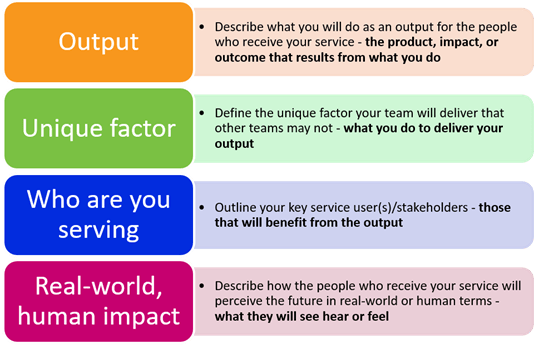Taking time out to create an improvement team vision statement that helps to describe the quality of person-centred care or support that the team want for people who interact with their service can be helpful for a new Reflective Improvement Group.
This activity can be used as a way of involving the whole group in shaping the future of person-centred care or support in their service. This can also help to keep the group focused, support ownership and commitment to the success of the group, and frame group discussions to ensure that people who use the service are at the center of all decisions and changes.
An improvement team vision statement is also a way to explain clearly to others what the team's quality and improvement aspirations are and helps the team to remain focused on what’s important.
The difference between a mission statement and a vision statement is that a mission statement is about what you do now (your approach and objectives) whereas a vision statement is firmly based on the desired future. There are many approaches to developing a vision statement, one example is shown below.
Vision statement framework

Example improvement team vision statement

Team reflection
Using reflection to capture new knowledge or feelings about hearing care experience feedback (positive or negative) can help a team to continuously learn and improve. Building reflection into an improvement meeting is a big part of being an effective improvement team, as it gives those involved the ability to learn and adapt quickly.
Doing this can be challenging because when work is busy it can be difficult to find and justify the time to reflect on what feedback means for the quality of care and support delivered by the team, but it is important to find time and ways to put what is learned from feedback into action.
Important questions to help teams reflect on experience feedback include:
- What do you notice?
- What are you curious or wonder about?
- How does this make you feel?
- What improvement opportunities does this present?
- What improvement ideas could you try?
It can also be helpful to use tools such as those used in Values Based Reflective Practice to support team reflection on narrative feedback. The ‘three levels of seeing’ tool works well when used immediately following the team hearing or reading feedback and then the NAVVY tool helps to create a space between the ‘issue’ and any proposed ‘solution so that teams don't jump to solutions.
